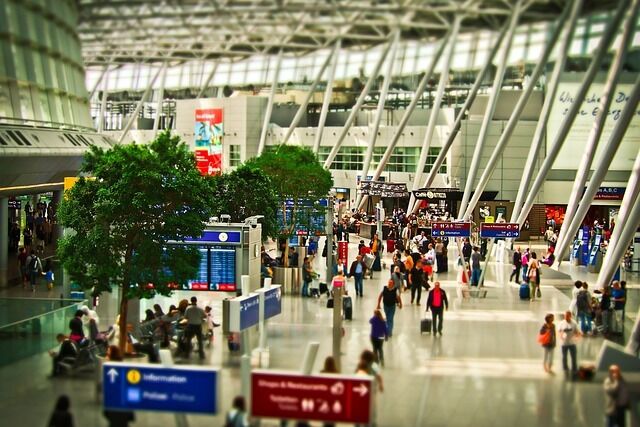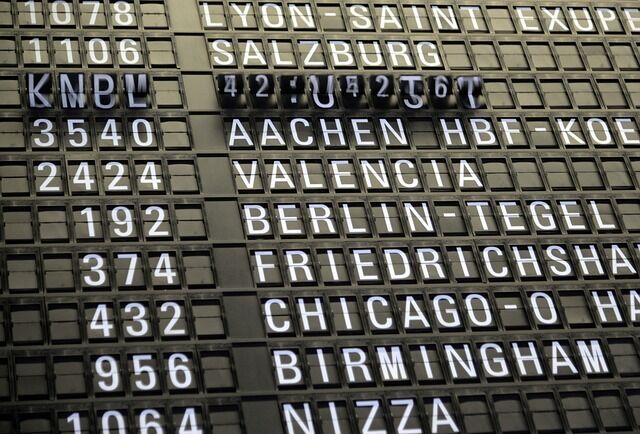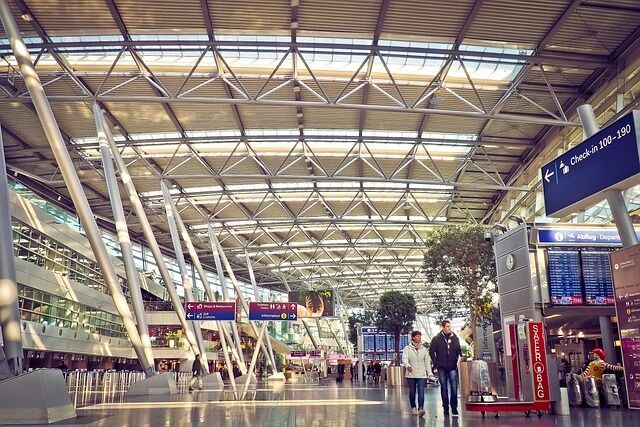America's air harbors: the largest airports in the United States

The journey begins at the airport. The United States' greatest air hubs are more than just landing and takeoff points. They are true hubs of life, connecting continents, cultures, and people.
What makes these airports so special? Size, infrastructure, and passenger traffic, of course. We'll tell you about the real giants: what unique opportunities they offer travelers.
Let's go to the most exciting airports in America!
Denver International Airport
A majestic air hub in Colorado, where hundreds of thousands of passengers travel or return home every day.
What makes this one so special? First of all, its size. With 140 square kilometers of space, Denver Airport is the largest in the United States and the second largest in the world. It is home to the longest runway in North America, allowing for non-stop reception of all types of aircraft. And the impressive craggy mountain peaks that greet visitors at the entrance have become a true local landmark.
Denver has everything you need for a comfortable travel experience:
- automated baggage management system;
- free Wi-Fi;
- comfortable waiting areas;
- plenty of restaurants and stores.
And, of course, you can meet travelers from all corners of the world here – each with their own story and their dreams.
Denver Airport, one of the largest air hubs in the U.S. – this is where unforgettable adventures begin.
Dallas/Fort Worth International Airport

Texas is home to one of the largest and busiest international airports in the United States – Dallas/Fort Worth. It is considered the largest in Texas, the second largest in the United States (after Denver International Airport), and the third largest in the world. It covers 7,315 acres, which is about the size of 10,000 soccer fields! Dallas/Fort Worth serves a huge number of passengers and takeoffs and landings each year.
The airport was opened on January 13, 1974. Since then, it has become not only an important transportation hub but also a symbol of modern aviation.
Dallas/Fort Worth International Airport consists of several terminals, each serving different airlines and destinations:
- Terminal A. Here you'll find flights from American Airlines and other airlines.
- Terminal B. Even more airlines and convenient gates.
- Terminal C. International flights and plenty of stores and restaurants.
- International Terminal D. For those traveling abroad.
- Terminal E. This is where American Eagle Airlines is based.
The airport is huge, so arrive early to make it through check-in and security.
Dallas/Fort Worth International Airport is one of the largest air hubs in the U.S. where your journey will begin.
Orlando International Airport
One of the major commercial civilian airports in the United States. It is located 11 kilometers southeast of the city center.
In 2017, Orlando handled 44,611,265 passengers, making it the busiest airport in the state of Florida and the eleventh busiest in the United.
Orlando's air hub is an additional hub for AirTran Airways, Southwest Airlines, and JetBlue Airways. This means you can choose from a variety of flights and destinations.
Orlando offers comfortable waiting areas, restaurants, shopping, free Wi-Fi, and other passenger amenities.
Orlando International Airport is the crash pad for the Space Shuttle transportation spacecraft.
Orlando International Airport is not only a point of departure but also an important link in the journey, opening up many opportunities for passengers.
O'Hare International Airport in Chicago – 73.9 million passengers

This air hub is the largest in the city and one of the busiest in the world. It is located in the northwestern part of Chicago, Illinois, USA.
O'Hare Airport covers a vast area of 73.9 square kilometers. It is the place where heaven and earth merge into a single space for traveling.
O'Hare is the main hub for United Airlines and the second largest hub for American Airlines after Dallas/Fort Worth. This is where routes intersect and passengers travel to different parts of the world.
O'Hare has several terminals:
- United Airlines;
- American Airlines;
- international terminal.
O'Hare also plays an important role in handling cargo flights, receiving airplanes from 60 foreign hubs.
O'Hare is recognized as the best airport in North America by readers of American publications. Despite its busy schedule, it continues to be an important air gateway for Chicago and the world.
San Francisco International Airport
The important air hub serving San Francisco and the Bay Area of California in the United States covers 21.07 square kilometers.
The airport opened in 1927 and was named Mills Field Municipal Airport of San Francisco. During World War II, the word "International" was added to the name as active international service began here.
In 2023, San Francisco was the fourteenth busiest in the United States and the thirtieth busiest in the world in terms of passengers. It is the fifth largest hub for United Airlines as well as Alaska Airlines.
The airport has its zip code and provides a comfortable environment for travelers. Restaurants, stores and even a museum can be found here.
San Francisco International Airport is a place where every passenger will be satisfied.
Los Angeles International Airport

This major US air hub is located just 16 kilometers from downtown Los Angeles, California.
The airport opened in 1928 and has since become one of the busiest in the world. Its history is linked to the development of aviation and the culture of Los Angeles. Movies have been filmed here, famous events have taken place and stars have met here.
In 2023, Los Angeles served 75.1 million passengers, serving as an important hub for many airlines including United Airlines, American Airlines, Delta Air Lines, and others.
Restaurants, stores, art galleries, and even gardens can be found here. For example, the Tomlinson Terminal is famous for its contemporary art and cultural exhibitions.
Los Angeles Airport offers travelers modern amenities:
- free Wi-Fi;
- gadget charging stations;
- comfortable waiting areas;
- special lounges.
Los Angeles International Airport is one of the largest air hubs by passenger traffic in the United States for new adventures.
Salt Lake City International Airport
It is Utah's largest commercial and military airport, located just 6 kilometers west of downtown Salt Lake City. It is the only civilian hub for the agglomeration, which has a population of over 2.5 million residents.
Since its opening in 1911, it has become an important hub for passenger and freight transportation. It serves as the main hub for Delta Air Lines and regional carriers SkyWest Airlines and Mesaba Airlines, operating under the Delta Connection brand name.
In 2008, more than 20.7 million passengers passed through Salt Lake City. More than 450 scheduled flights on 109 routes to cities in the U.S., Canada, and Mexico, as well as non-stop flights to Paris and Tokyo, are served here daily.
More than 350 scheduled flights are operated daily from Salt Lake City International Airport, and the air harbor ranks first in punctuality of departure and arrival of scheduled passenger flights in the United States.
Salt Lake City International Airport is not only an important transportation hub, but also a place where history, modernity, and plenty of travel intertwine.
McCarran International Airport in Las Vegas

Located just 8 kilometers south of downtown Las Vegas, covering an area of 11 square kilometers, it is the main commercial airport for the city of Las Vegas and Clark County in the state of Nevada, USA.
McCarran International Airport opened in 1942 and has since become a key hub for passenger and cargo transportation. In 2021, more than 41.5 million people traveled through it. McCarran ranks eighth in the world in terms of takeoffs and landings and twenty-fourth in terms of passenger traffic
McCarran serves as a major hub for airlines such as:
- Allegiant Air;
- US Airways;
- Southwest Airlines.
The airport has four runways and two commercial terminals and provides a comfortable environment for travelers.
McCarran International Airport is not only an important transportation hub, but also a place where excitement, entertainment and endless possibilities merge.
Miami International Airport
A civilian air port located just 13 kilometers northwest of downtown Miami. It covers an area of 1,300 hectares and is one of the key air gateways between the United States and Latin America.
The Miami terminal opened in 1928 and has since become an important hub for passenger and cargo transportation. In 2022, more than 44 million passengers passed through it, making it one of the busiest airports in the world.
Miami is a hub for American Airlines, which operates many flights to Latin America, as well as its regional partner American Eagle.
Due to its growing tourist traffic, local economy, and strategic location, Miami plays an important role in transportation between North America, Latin America, and Europe.
Miami Airport handles the highest amount of international cargo of any hub in the United States.
Miami International Airport is not only a departure and arrival point but also an important link in the global aviation infrastructure.
John F. Kennedy International Airport

The largest international air hub in the United States, located in the Queens borough of southeastern New York City. It is located just 20 kilometers southeast of Lower Manhattan and covers an area of 1995 hectares.
The terminal began operations in 1947 under the name Idlewild, after the golf course on which it was built. In 1963, it was renamed in honor of the 35th President of the United States - John F. Kennedy.
John F. Kennedy International Airport serves as a major hub for American Airlines, Delta Air Lines and JetBlue and is the nation's number one international airline hub. It serves more than 90 airlines and connects the U.S. to numerous countries around the world. In 2023, more than 61.9 million passengers traveled through it.
As you pass through John F. Kennedy International Airport, you can feel not only modernity, but also a connection to the great events of the past.
This airport is not only the air gateway to New York City, but also a place where history, modernity and endless travel opportunities intertwine.
Having used the largest airports in the US, you'll be pleased with the efficiency and automation. Modern technology speeds up the check-in, security and boarding processes. Automation and biometric identification reduce staff workload and improve the travel experience. Also, the rational placement of security and control areas helps to manage overcrowding and speed up throughput. Your journey will be enjoyable and carefree. Enjoy your flight!



















